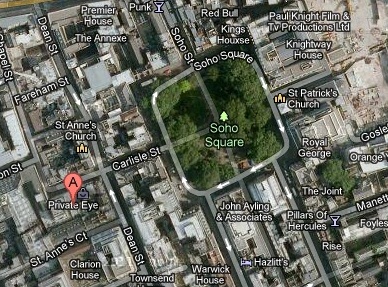Google Adds Grand Canyon, Terrain Features To Maps

Google has added information about terrain, vegetation and other features to its Google Maps, while also bringing in Street View images of the Grand Canyon and New England’s autumn leaves
Google Maps is adding detailed information about topography, vegetation, terrain and land formations to its wide-ranging Google Maps collection.
“When you look at Google Maps, we want you to see the most comprehensive, accurate and easy-to-understand representation of the entire world,” wrote Karl Johann Schmidt, a software engineer with Google Maps in a 26 October post on the Google Lat Long Blog. “Today, we’re unveiling some visual improvements to the basemap that will help enable that goal.”
Natural land formations
Among the new features are colour gradations to depict vegetation and labels for natural land formations, which are aimed at helping visitors to “quickly and easily see where the great forests, deserts, and mountain ranges around the world begin and end”, wrote Schmidt. “It also conveys how natural land formations can impact where, how and why man-made developments like urban cities, dams and bridges are made.”
 Also new to the maps are labels for large natural features to help delineate them on the maps with more clarity. “So when you search Google Maps for dozens of natural land formations like the Gobi Desert, Melville Peninsula, or Nullarbor Plain, you’ll see improved, well-labelled results,” wrote Schmidt. “We hope this new visual information literally provides you with a more comprehensive and accurate lay of the land, and comes in handy whether you’re planning a trip or just browsing the map.”
Also new to the maps are labels for large natural features to help delineate them on the maps with more clarity. “So when you search Google Maps for dozens of natural land formations like the Gobi Desert, Melville Peninsula, or Nullarbor Plain, you’ll see improved, well-labelled results,” wrote Schmidt. “We hope this new visual information literally provides you with a more comprehensive and accurate lay of the land, and comes in handy whether you’re planning a trip or just browsing the map.”
Meanwhile, Google is also at work expanding its Street View image collection, this time starting an effort to collect photographs of the Grand Canyon and its beauty.
“Today, demonstrating the rocky and rugged paths we’ll travel to make Google Maps even more complete, we’re collecting imagery from a place no car, trike or snowmobile has ever been before,” wrote Ryan Falor, product manager with Google Street View, in a 24 October post on the Google Lat Long Blog. “On its first official outing, the Street View team is using the Trekker – a wearable backpack with a camera system on top – to traverse the Grand Canyon and capture 360-degree images of one of the most breathtaking natural landscapes on the planet.”
The Trekker camera backpack is controlled by its operator using an Android phone as it automatically gathers photos as the operator walks, according to Falor.
“This week, photos are being gathered from portions of the South Rim at Grand Canyon National Park, including the ridge, the famous Bright Angel Trail, South Kaibab Trail and more. These panoramic views will soon be live on Google Maps, giving everyone from real-life visitors to armchair travelers the opportunity to marvel at this beautiful, majestic site from the comfort of their computers or mobile devices.”
Grand Canyon images
For viewers who don’t want to wait a few months until the images are collected and catalogued in Street View, they can go online today to see detailed Grand Canyon images on display at the General Mills Nature Valley Trail View website, according to the independent Google Maps Mania blog.
Also on Google Maps Mania, a map highlighting the autumn leaf conditions in New England is available to allow viewers to get a glimpse of the autumn colours in the northeast. Users can submit their own photos to the map to show the colours to others.
Google maps recently added 25 million building footprint images to its map collection, giving users more information and details about structures they are trying to locate.
Earlier in October, Google updated the Street View images that can be seen in Google Maps along more than 250,000 miles of roads around the world, while also doubling the size of its Street View image collection overall. It was the largest one-time Street View image update ever by the company.
Those new image collections now include detailed photographs of places such as Catherine Palace and Ferapontov Monastery in Russia, the Chiang Kai-shek Memorial Hall and Taroko Gorge in Taiwan, Stanley Park in Vancouver, Canada, and of Singapore’s urban jungle, Fort Canning Park.
In September, Street View added its first-ever underwater panoramic images, bringing in photographs of underwater reefs in Australia, Hawaii and the Philippines. The images came from the Caitlin Seaview Survey, which is conducting scientific expeditions to explore and map the world’s coral reefs.
Universities
Also added in September were Street View images for more than 150 universities around the world, giving online users “you are there” glimpses into more institutions of higher learning in the United States, Japan, Europe and elsewhere. Included in the schools update were UCLA, Pembroke College in the UK, McGill University in Canada, University of California-Davis, Amherst College, Bowdoin College, Emory University, Florida Atlantic University, Loyola Marymount University, Stetson University, University of Notre Dame and Washington State University.
In August, Google Street View expanded its library by adding images of the remote and beautiful Canadian Arctic hamlet of Cambridge Bay, as well as detailed 360-degree images of retired spacecraft, launching facilities and other notable scenes at NASA’s Kennedy Space Centre on the Florida coast. New Street View images tracking the rebuilding of New Orleans following the devastation of 2005’s Hurricane Katrina also debuted.
What do you know about Windows? Take our quiz.
Originally published on eWeek.